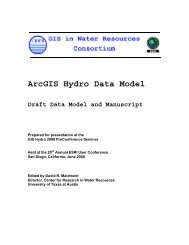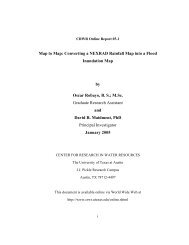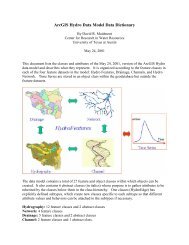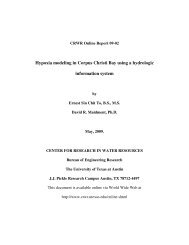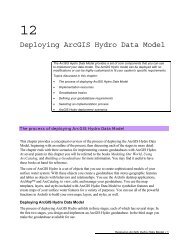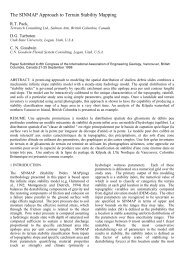View the Whole Report - Center for Research in Water Resources ...
View the Whole Report - Center for Research in Water Resources ...
View the Whole Report - Center for Research in Water Resources ...
You also want an ePaper? Increase the reach of your titles
YUMPU automatically turns print PDFs into web optimized ePapers that Google loves.
<strong>the</strong> discharge was 1542 mg/L, with a median concentration of approximately 500 mg/L.<br />
The large difference between <strong>the</strong> two values is <strong>the</strong> result of a s<strong>in</strong>gle sample with an<br />
extremely high concentration, so <strong>the</strong> median is probably more representative of <strong>the</strong> water<br />
quality normally discharged from <strong>the</strong>se structures.<br />
The efficiency of <strong>the</strong> geotextile silt fences was based upon a comparison of <strong>the</strong><br />
particle load<strong>in</strong>g of <strong>the</strong> upstream pond and <strong>the</strong> effluent downstream. This procedure<br />
allowed <strong>the</strong> determ<strong>in</strong>ation of <strong>the</strong> removal efficiency of <strong>the</strong> silt fence alone and ignored<br />
removal attributed to sedimentation. The TSS removal efficiency was calculated by:<br />
TSS reduction % =<br />
Upstream TSS (mg/L)- Downstream TSS (mg/L)<br />
Upstream TSS (mg/L)<br />
x 100<br />
The median removal efficiency determ<strong>in</strong>ed <strong>in</strong> this manner was 0%, with a<br />
standard deviation of ±26%. The range <strong>in</strong> calculated efficiencies was -61% to 54%. A<br />
negative reduction signifies an observed <strong>in</strong>crease <strong>in</strong> TSS downstream of <strong>the</strong> silt fence.<br />
M<strong>in</strong>or errors <strong>for</strong> <strong>in</strong>-situ sampl<strong>in</strong>g at construction sites are typical. O<strong>the</strong>r sources of error<br />
which could result <strong>in</strong> negative removal efficiencies <strong>in</strong>clude: disturbance of bottom<br />
sediments dur<strong>in</strong>g sample collection and comm<strong>in</strong>gl<strong>in</strong>g of filtered and unfiltered flows<br />
below <strong>the</strong> silt fence. The TSS removal efficiencies <strong>for</strong> sample pairs are presented <strong>in</strong> Table<br />
B3 <strong>in</strong> Appendix B.<br />
The highest removal rate calculated was 54%. This removal corresponds to<br />
samples collected <strong>for</strong> a non-woven fabric, <strong>in</strong>let perimeter protection silt fence at Site 4.<br />
The higher efficiency may be attributed to shallow depth of <strong>the</strong> ponded water. The<br />
maximum depth at this location was estimated to be only 15 centimeters. Us<strong>in</strong>g Stokes'<br />
Law, and assum<strong>in</strong>g:<br />
k<strong>in</strong>ematic viscosity = 0.01 cm 2 /s,<br />
particulate specific gravity = 2.65, and<br />
median particle size = 9.5 µm (small silt),<br />
28




